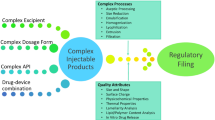Abstract
The O-alkyl-N-aryl thiocarbamate, I, (2-chloro-5-[[(l-methyl-ethoxy)thioxomethyl]amino]benzoic acid, 1-methylethylester, NSC 629243, also known as Uniroyal Jr.) is an experimental anti-HIV drug with very low water solubility (1.5 µg/mL). Early clinical studies required an injectable solution at ≈15 mg/mL, representing a solubility increase of ≈104-fold. Adequate solubilization of this hydrophobic drug was achieved in 20% lipid emulsions. Extemporaneous emulsions were prepared by adding a concentrated drug solution to a commercially available parenteral emulsion. Various methods of preparation to minimize drug precipitation during its addition and enhance redissolution of precipitated drug were evaluated. The stability and mechanism(s) of decomposition of NSC 629243 in both 20% lipid emulsions and in natural oil vehicles were examined. In lipid emulsions, the shelf life at 25°C varied from 1 to >10 weeks, depending on the extent to which air was excluded from the preparation. The shelf life of 50 mg/mL solutions in natural oils at 25°C varied from <1 to >100 days depending on the oil and its supplier. A qualitative correlation was found between the initial rate of oxidation and the peroxide concentration in the oil. The primary degradation product in both systems was shown to be a disulfide dimer, II, formed via oxidation. Oxidation was inhibited by vacuum-sealing of emulsion formulations or incorporation of an oil-soluble thiol, thioglycolic acid (TGA), into oil formulations. TGA may inhibit oxidation by consuming free radicals or peroxide initiators or by reacting with the disulfide, II, to regenerate the starting drug.
Similar content being viewed by others
REFERENCES
J. Palca. The growing anti-HIV armamentarium. Science July 19:263 (1991).
A. A. El-Sayed and A. J. Repta. Solubilization and stabilization of an investigational antineoplastic drug (NSC no. 278214) in an intravenous formulation using an emulsion vehicle. Int. J. Pharm. 13:303–312 (1983).
I. Oh, S.-C. Chi, B. R. Vishnuvajjala, and B. D. Anderson. Stability and solubilization of oxathiin carboxanilide, a novel anti-HIV agent. Int. J. Pharm. 73:23–31 (1991).
A. Magill and A. R. Becker. Spectrophotometric method for quantitation of peroxides in sorbitan monooleate and monostearate. J. Pharm. Sci. 73:1663–1664 (1984).
S. H. Yalkowsky and T. J. Roseman. Solubilization of drugs by cosolvents. In S. H. Yalkowsky (ed.), Techniques of Solubilization of Drugs, Marcel Dekker, New York, 1981, pp. 91–134.
M. E. Brewster, K. S. Estes, and N. Bodor. An intravenous toxicity study of 2-hydroxypropyl-β-cyclodextrin, a useful drug solubilizer, in rats and monkeys. Int. J. Pharm. 59:231–243 (1990).
W. I. Higuchi. Rate of solute transport out of emulsion droplets in micron size range. J. Pharm. Sci. 53:405–408 (1964).
J. Li. Sedimentation Field Flow fractionation Refinements and Application to Emulsion Characterization, Ph.D. thesis, University of Utah, Salt Lake City, 1993.
Author information
Authors and Affiliations
Rights and permissions
About this article
Cite this article
Strickley, R.G., Anderson, B.D. Solubilization and Stabilization of an Anti-HIV Thiocarbamate, NSC 629243, for Parenteral Delivery, Using Extemporaneous Emulsions. Pharm Res 10, 1076–1082 (1993). https://doi.org/10.1023/A:1018935311304
Issue Date:
DOI: https://doi.org/10.1023/A:1018935311304




